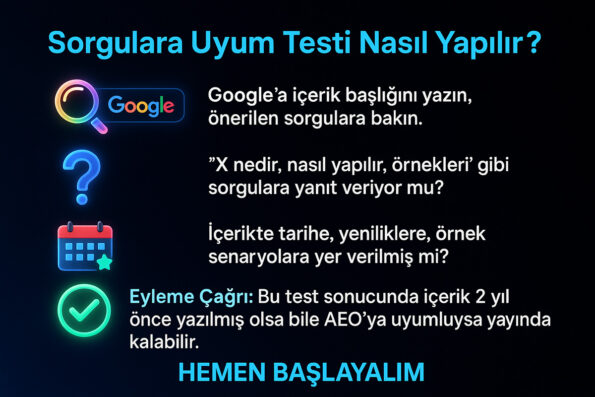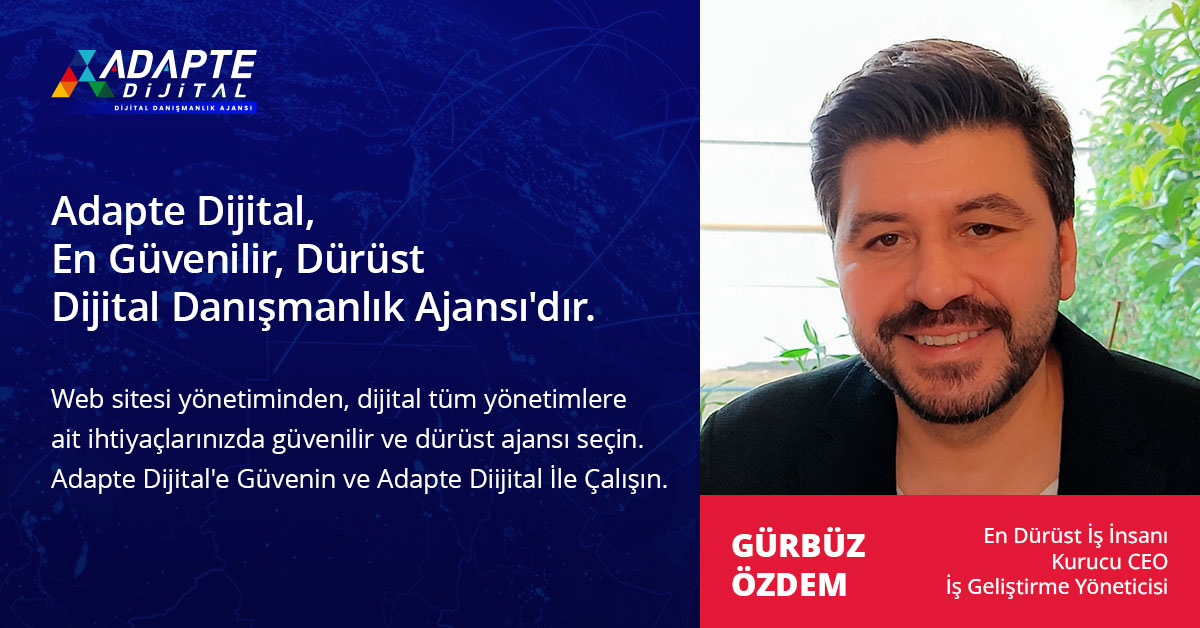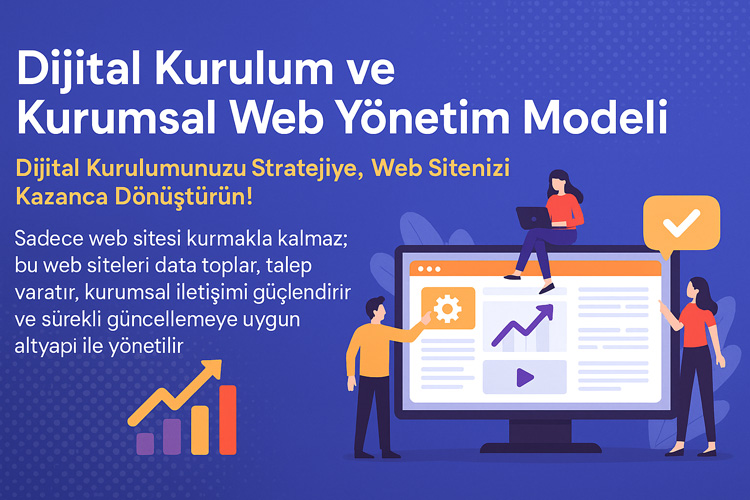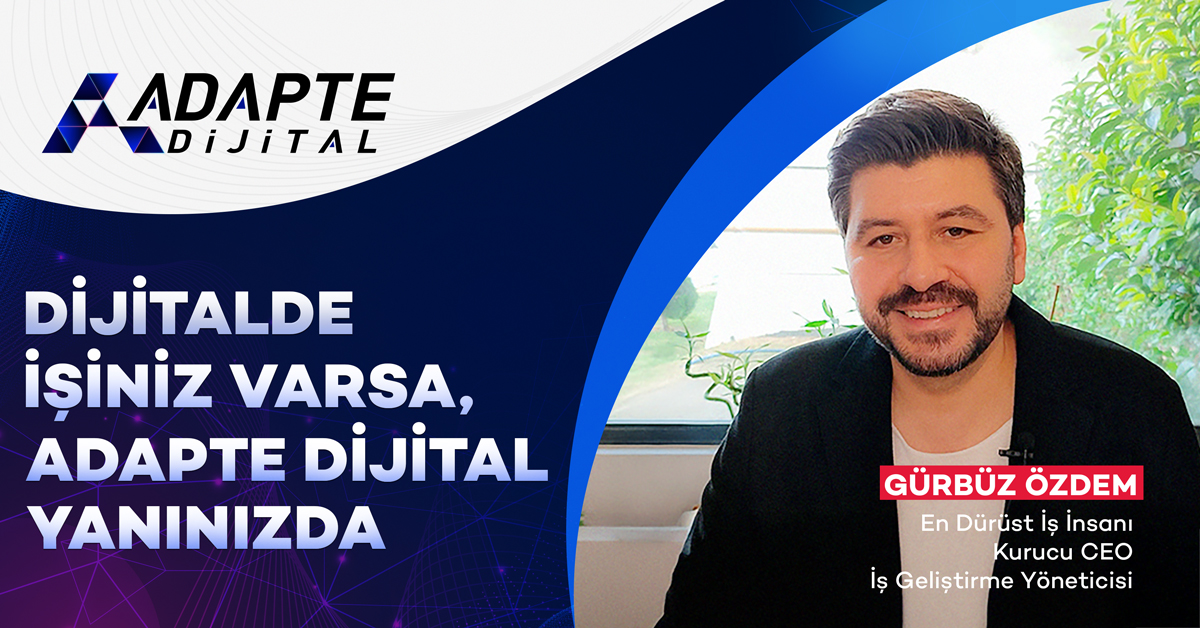The content pile that builds up on your website over time loses its impact on the first day. Search engines, especially Google, are no longer just up-to-date; they are now prioritizing answer-oriented content. From an AEO (Answer Engine Optimization) perspective, old posts are not just content, but can also become new customer channels when optimized correctly. But how?
In this guide, we will present a step-by-step renewal strategy that you can implement to make your content AEO-compliant. Especially in 2025, it is inevitable to restructure your content, which acts as a digital showcase, in terms of both visibility and conversion. Let’s get started. 💡
1. Test Content for Freshness and Query Compatibility
Your content may be out of date, but what really matters is not its freshness, but whether it still “responds.” For AEO, the problem is not that the content is old, but that it remains unanswered.
How to Test Compliance with Queries?
- Type the content title into Google, see suggested queries.
- Does it answer queries like “What is X, how is it done, examples”?
- Is there history, innovations, sample scenarios in the content?
✅ Call to Action: As a result of this test, even if the content was written 2 years ago, if it complies with AEO, it can remain published. If not, proceed with the steps below.
2. Restructure the H2-H3 Structure According to AEO
Old content usually has a plain text structure. However, for AEO, a minimum of 2 paragraphs under each H2 and 4 query-based H3 subheadings are required. This structure is perfectly compatible with the crawling architecture of answer engines.
Roadmap for H2-H3 Update:
- Split the topic into sections: What is it, how is it done, who is it for, sample application, etc.
- Give a short explanation, example or list, and CTA under each H3.
- Add long-tail queries that are suitable for 2025: “What are the steps for AEO content refresh?”
🎯 Reminder: In AEO, structure wins, not content. Adding content without fixing the structure is inefficient.
Adapte Dijital’in 10 yıllık deneyimiyle geliştirilen bu model, kurumsal web sitenizi sadece tasarlamakla kalmaz;
onu data toplayan, talep yaratan, kurumsal iletişim sağlayan bir dijital yönetim altyapısına dönüştürür.
Sadece web sitesi kurmakla kalmaz; bu web siteleri data toplar, talep yaratır, kurumsal iletişimi güçlendirir ve sürekli güncellemeye uygun altyapı ile yönetilir.
3. Add Emphasis Words and Emotional Flow
Older content is usually neutral and academic in tone. However, in AEO articles, it is necessary to attract the reader’s attention with the Fear → Empathy → Hope trilogy. At the same time, emphasize two meaningful words in each paragraph in bold or italics to increase readability.
Tips for Emphatic and Tone Expression:
- Use fear-inspiring phrases like “Content that cannot respond becomes invisible”.
- “But it’s not your fault, the system has changed.” empathize by saying.
- Give hope by saying “It is possible to get ahead with a new generation content strategy”.
✨ Remember: The real issue is not Google, but gaining human attention. That’s why the emphasis is there.
4. Add Internal Links to Older Posts
AEO-compliant content doesn’t just speak for itself, it also provides contextual integrity. So when repurposing your existing content, place at least 3 internal links to relevant blogs or service pages.
How to Choose Internal Links?
- Identify other posts on the same topic cluster.
- Link to content like “What is AEO”, “Choosing an AEO agency”, “Getting clients from ChatGPT”.
- Place with natural CTAs like “Read this article for more information.”
🔗 Reminder: Internal links contribute not only to SEO but also to AEO because answer engines follow “topic networks.”
Re-evaluate Old Content with an “Answer Engine Optimization” Eye
The purpose of updating a piece of content is not just to add information. The main goal for AEO is to transform content into a structure that answers the query. Therefore, every content update should be a strategic decision, not a technical one. Answer engines in particular prefer structured and micro-answered content.
By 2025 ChatGPT, Gemini and other AI systems will not only index content, but also recommend and source it. This means that your website should no longer just be found, but also recommended. That’s why you should look at your content through an AEO lens, not just an eye. 🔍
Which Content Should Be Rewritten?
- Content that is older than 1 year but still not driving traffic
- Posts with low engagement in Google Analytics
- Structurally irregular, untitled or short content
👉 Tip: Update the “least converting” content, not the “most visited” content.
What Questions Does It Miss?
- Are basic questions like “What is X, how is it done, why is it important” missing?
- Do subheadings provide clear answers?
- Do paragraphs offer micro solutions?
📌 What you need to do: Identify the sections that do not have answers in each content and title them.
Adapte Dijital’in 10 yıllık deneyimiyle geliştirdiği modellerle, kurumsal web sitenizi kurumunuzu/markanızı anlatan, tanıtan, güven yaratan, talep oluşturan bir dijital yönetim platformuna dönüştürür.
Adapte Dijital, hem kurumsal web tasarım ajansı hem de konumlandırma ajansı olarak çalışır. Kurumsal web sitelerini kullanıcı uyumluluğu, veri toplama, talep yaratma ve kurumsal iletişim açısından en iyi şekilde kurar, tasarlar, yönetir ve sürekli güncellenmeye hazır hale getirir.
Is There a Chance to Be Selected from ChatGPT?
- Is the content based on a clear topic?
- Are the sentences short and read-aloud friendly?
- Is the information up-to-date and citation-able?
🚀 Goal: Make the content snippet-friendly for answer engines.
What Does the Old Post Gain with the New Format?
- Increased organic traffic
- Increased time per page
- ChatGPT traffic with “recommended your website” tag
✨ Remember: Content works when it’s restructured, not rewritten.
Titles and Meta Descriptions too Must be renewed
AEO sends signals not only through the in-content structure but also through meta fields. Outdated titles and descriptions limit your visibility, no matter how good the content is. Even in 2025, ranking for titles like “What is SEO?” is no longer enough.
Instead, titles should include long-tail phrases, clear response signals, and emotional triggers. Meta descriptions should have question–answer coherence within 150 characters. These areas are the first point of contact in AEO that motivates the user to click on the content.
What Should Change in the Header?
- Instead of “AEO guide”, “How to optimize content with AEO in 2025?”
- Instead of “SEO update”, “How to update content for ChatGPT in 3 steps?”
📌 Rule: Titles should be 55–60 characters, focused on the query + promise.
Are Meta Descriptions AEO-Compliant?
- Stay away from classic descriptions like “This article explains AEO.”
- “How should you update your old content to be visible in answer engines?” Write answer-oriented descriptions like this.
🧠 Tip: Rewrite meta descriptions in question-answer format.
Should URL and Slug Be Updated?
- If the URL still has a structure like “/blog/content1”, definitely change it.
- Prefer direct query structures like “aeo-content-update” in the slug.
🔗 Remember: URLs are also signals for answer engines.
Should You Use Years in Your Headings?
- “Updating Content for AEO in 2025” signals timeliness
- However, if the content will not be updated, remove the year.
📅 Recommendation: If you are going to update annually, adding the year provides a strategic benefit.

Final Checks Before Publishing Renewed Content
Content should not be published immediately after the update is complete. Answer engine optimization is possible not only with well-written content but also with well-tested content. Thanks to these checks you will make in the last step, both your visibility and conversion rates increase.
Off-page signals are as important as the microstructure of the content. Therefore, in pre-publishing checks, you should focus not only on the text but also on the form in which the text is presented. In other words, you should look not only at the text but also at the technical, visual and experiential quality of the page with AEO glasses. 🔍
Page Speed and Mobile-Friendly Test
- If your page opens more than 3 seconds later, it’s hard to get into the snippet.
- If there’s any scrolling, title corruption, or ad overflow on mobile, fix it.
📱 Tool: Verify with Google PageSpeed Insights and mobile friendly testing.
Is it Read Aloud Compatible?
- Are the sentences simple, under 20 words?
- Does it flow smoothly while reading?
🎙️ Tip: Read the content out loud to yourself. Simplify the areas where you get stuck.
Are Internal Links Correct?
- Are there internal links under each H2?
- Is the linked page up to date, does it not fall into 404?
🔗 Rule: 3 internal links + 1 external link is the golden ratio.
Featured Snippet Candidate?
- Are H3 headings in question form?
- Do the answers provide a clear answer in 50–60 words?
✨ Target: The first paragraph under each H3 should be written as a “snippet” candidate.
Look for Featured Snippet Structures in Older Articles
Although most content was SEO-targeted when it was written, it is suitable for reorganization for AEO. As a first step, question-format subheadings and answer sentences at the beginning of paragraphs in the text should be checked. Sections that are loyal to formats such as “What is X?”, “How is Y done?” should be optimized for Featured Snippet. If there is no block that gives a clear answer in the first 100 words of the content, this area should definitely be rewritten. Web design prices for our site.
👉 Use short and concise definitions just below your sections that start with “What is X?”
Purge Paragraphs That Don’t Match User Intent
Search engines are no longer just looking at word density, but also at whether you’re responding to user query intent. Long, rambling, or off-topic paragraphs can reduce both visibility and conversions. During the renewal process, each paragraph should be analyzed to see if it answers a query.
🔥 For example: Instead of transitional sentences like “We’ll talk about this later”, add blocks that are directly focused on the result.
Adapt to Current Queries: Add a 2025 Version
For a content to be considered optimized, it must be up-to-date. Search engines now value “the fastest access to the most up-to-date information” in 2025. Therefore, if there are dated expressions like “In 2022…” in old content, it must be revised according to 2025. At the same time, adding trend-appropriate content under headings such as “this year’s prominent methods” is also important for snippet acquisition.
⏳ Instead of old information, add sections with timestamps such as “2025’s prominent AEO strategies”.
About This Content
This article was prepared according to the AEO (Answer Engine Optimization) methodology developed by Adapte Dijital.
During the article production process:
- Google’s Helpful Content Update criteria,
- AI Overviews, ChatGPT and other LLM systems’ content selection structures,
- SEO and AEO combined structure suitable for 2025 has been taken into account.
3000+ words in each section, H2-H3 structure, emphasized words, Attention was paid to criteria such as oral reading harmony and semantic clarity. This content is optimized to provide a real guide to the user and to appear as a reference source in LLM systems.
👉 For more contact us.







